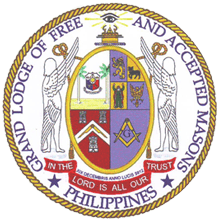Well-known Filipino Masons
OFFICIAL WEBSITE OF
QUEZON CITY LODGE NO.122

Named after Quezon City where it is located. The creation of Quezon City was the consuming dream of President Manuel L. Quezon. He picked the site of the city and did the entire spade work leading to its establishment.
Well-known Filipino Masons
Jose Rizal (1861-1896)

Jose Rizal was one of the earliest Filipino Masons. A National Hero, he was a patriot, physician and man of letters whose life and literary works were an inspiration to the Philippine nationalist movement.
He was made a Freemason in Madrid, Spain in 1884 where he associated with men of ideas. He pressed for Philippine independence from Spanish rule and in 1892 he organized the Philippine League to promote unity, cooperation and mutual help. However, almost immediately he was arrested for subversion and exiled.
Andres Bonifacio (1863-1897)

In Rizal’s absence, one of his followers, Andres Bonifacio, established the Katipunan – a society organized along Masonic lines with noble doctrines and with then necessary desire to obtain independence.
In 1886 Augustinian Friars learned of the Katipunan and it was confronted with the choice of breaking up or openly revolting. At a meeting of the Katipunan on August 26, 1886, Bonifacio renounced allegiance to Spain and the Philippine Revolution began.
Emilio Aguinaldo (1868-1964)

In March 1887 the rebels established a revolutionary government in place of the Katipunan; the soldier Emillio Aguinaldo – who had been successful in the fighting in the province of Cavite – was elected President, while Bonifacio was selected as Minister of Interior.
Meanwhile, the USA became drawn into a war with Spain over another Spanish colony, Cuba. As a result, the Americans sided with and lent support to the Philippine rebels.
On August, 13 1898 in Fort Santiago, Manila the Spanish flag was lowered after 327 years of Spanish rule, and in its place was raised the Stars and Stripes. America had become, almost by accident, a colonial power.
On June 12, 1898 Emillio Aguinaldo proclaimed the independence of a new Philippine Republic. However, the American’s claimed that the Philippines was not ready for self-government. This led to a new armed conflict which lasted for another two years, after which the country more-or-less accepted American rule – under Governor Taft (an American Mason). The American democratic system and the English language began to replace the Spanish influence; and, naturally, Philippine Masonry was modeled on American Freemasonry.
Gregorio Aglipay (1860-1940)

The formal launching, in 1902, of a Philippine national church called the Iglesia Filipina Independiente, was the culmination of a vision first raised at the Assembly of Paniqui which was convened in 1999 for the purpose of organizing the Filipino clergy. This assembly marked the beginning of a religious revolution that; came to affect the lives of a great number of Filipinos. At the forefront in convening the assembly was a man who was a former Catholic priest, a nationalist, a patriot, a guerrilla leader, and the first Supreme Bishop of the Iglesia Filipina Independiente. His name was Cregorio Aglipay Cruz y Labayan.
Manuel L. Quezon (1878-1944)

Manuel Luis Quezon joined the revolutionary forces of Gen. Emilio Aguinaldo during the revolution against Spain, he fought fearlessly by eventually was forced to surrender to the Americans and spent six months in jail. Quezon took the bar exam in 1903. In 1916 he was elected to the Philippine Senate and became its first President. He was the first President of the Commonwealth of the Philippines and the first Grand Master of Philippine Freemasonry.
After the Japanese occupation during the Second World War and bloody fighting in the Pacific, peace returned to the Philippines and on July 4, 1946 the Philippines was finally declared a sovereign and independent republic.
Jose P. Laurel (1891-1959)

The Japanese military authorities knew that they had failed to win the Filipino’s symphaty. but until the end, they had really tried to “tame” the Filipinos and gain their trust. They knew that the filipinos were freedom loving and finally they conceded that Japan will grant the Philippines’ independence as long as it will recognize Japan’s program of establishing a Greater East Asia co-prosperity sphrere. The Filipino leaders, knew that the independence promise was empty but they could not laugh for it would mean execution. They created the Preparatory Commision for Philippine Independence. The delegates were chosen and 5 days later, Jose P. Laurel was elected president.
With Laurel as president, the Republic tried to solve the grave economic and social prolems. Peace and order was in shambles due to the guerilla units. The lack of food was also a problem. Robbery was also a common problem during his administration. Laurel appealed to the guerillas not to aggravate the already bad situation.
